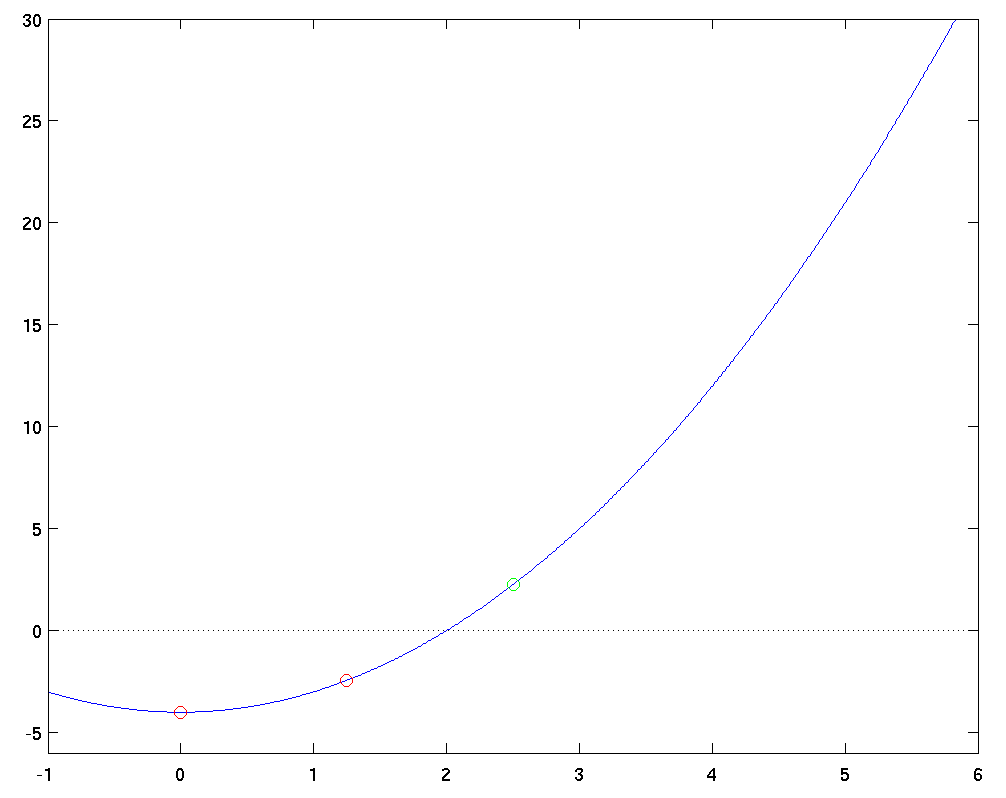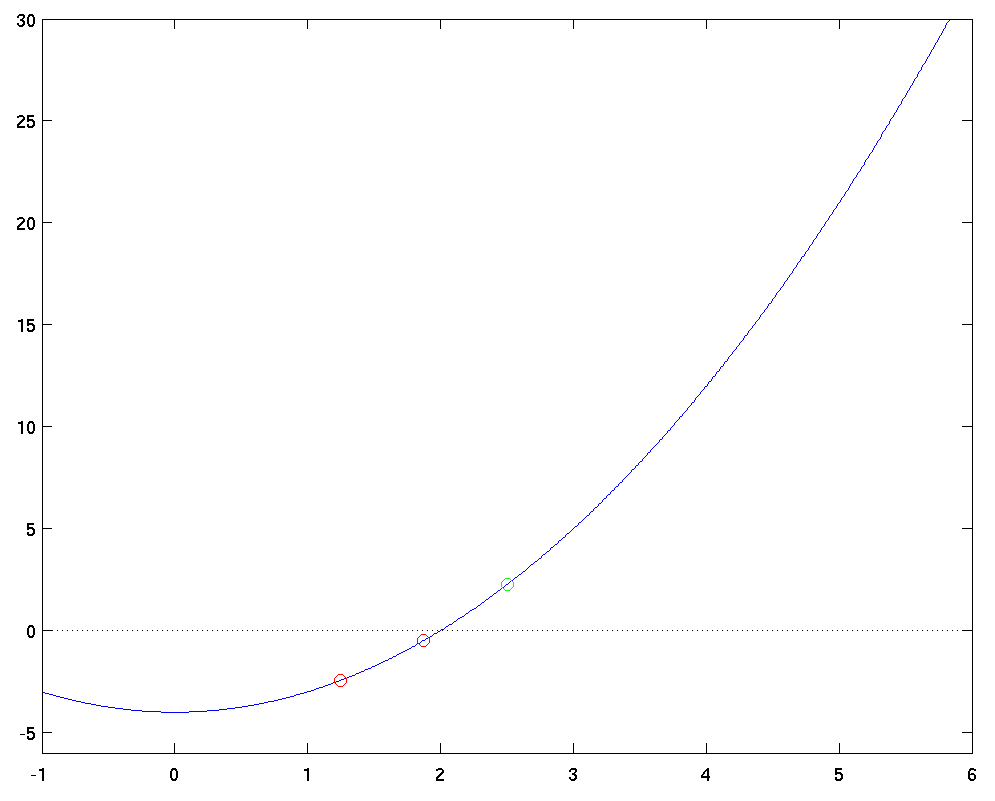
 Copyright © Michael Richmond.
This work is licensed under a Creative Commons License.
Copyright © Michael Richmond.
This work is licensed under a Creative Commons License.
One general approach to finding roots is via so-called "closed" methods.
See Chapter 5 of your textbook for more information on these methods.
A closed method is one which starts with an interval, inside of which you know there must be a root. At each step, the method continues to produce intervals which must contain the root, and those intervals steadily (if slowly) shrink. These methods are guaranteed to find a root within the interval, as long as the function is well-behaved.
Open methods can be much faster, but they give up this certainty.
The two closed methods discussed here also require only that you be able to evaluate the function at some point; they do not require that you also be able to evaluate the function's derivative.
Given some function f(x) which is real and continuous, and given some interval [x1, x2] inside of which you want to check for a root, do the following:
Good things about the bisection method:
Bad things about the bisection method:
Let's look at a specific example of the bisection technique:
find a root of the equation y = x^2 - 4 on interval [0, 5]
stop when relative fractional change is 1e-5
The exact root is 2, of course.
How quickly can we find it, to within the given termination criterion?
Let's watch the method in action, one step at a time. First, we need to calculate the value of the function at the bottom of the interval (x1 = 0), and the top of the interval (x2 = 5). We also make our first guess: the midpoint of the interval, x_new = 2.5, and evaluate the function there, too.

Now, looking at the sign of the function at each of these points, we see that
We now repeat the bisection's basic step: find the midpoint of the current interval (x_new = 1.25), and look at the sign of the function at the endpoints and the midpoint.

This time, the function changes value between the midpoint x_new = 1.25 and the upper bound x2 = 2.5. That means that we'll discard the old lower bound, and re-set it so that x1 = 1.25 for the next step. Our interval is now [1.25, 2.5].
Going back to the top of the loop, we find the midpoint x_new = 1.875, and evaluate the function here and at the endpoints.

It looks like we'll have to move the lower bound again in the next step ...
You can watch the progress of the bisection method in these movies:
Here's a table showing the method in action:
lower value at upper value at fractional
iter bound lower bound bound upper bound change
------------------------------------------------------------------------------
iter 0 0.0000000e+00 -4.0000e+00 5.0000000e+00 2.1000e+01 1.0000e+00
iter 1 0.0000000e+00 -4.0000e+00 2.5000000e+00 2.2500e+00 1.0000e+00
iter 2 1.2500000e+00 -2.4375e+00 2.5000000e+00 2.2500e+00 3.3333e-01
iter 3 1.8750000e+00 -4.8438e-01 2.5000000e+00 2.2500e+00 1.4286e-01
iter 4 1.8750000e+00 -4.8438e-01 2.1875000e+00 7.8516e-01 7.6923e-02
iter 5 1.8750000e+00 -4.8438e-01 2.0312500e+00 1.2598e-01 4.0000e-02
iter 6 1.9531250e+00 -1.8530e-01 2.0312500e+00 1.2598e-01 1.9608e-02
iter 7 1.9921875e+00 -3.1189e-02 2.0312500e+00 1.2598e-01 9.7087e-03
iter 8 1.9921875e+00 -3.1189e-02 2.0117188e+00 4.7012e-02 4.8780e-03
iter 9 1.9921875e+00 -3.1189e-02 2.0019531e+00 7.8163e-03 2.4450e-03
iter 10 1.9970703e+00 -1.1710e-02 2.0019531e+00 7.8163e-03 1.2210e-03
iter 11 1.9995117e+00 -1.9529e-03 2.0019531e+00 7.8163e-03 6.1013e-04
iter 12 1.9995117e+00 -1.9529e-03 2.0007324e+00 2.9302e-03 3.0516e-04
iter 13 1.9995117e+00 -1.9529e-03 2.0001221e+00 4.8830e-04 1.5260e-04
iter 14 1.9998169e+00 -7.3239e-04 2.0001221e+00 4.8830e-04 7.6295e-05
iter 15 1.9999695e+00 -1.2207e-04 2.0001221e+00 4.8830e-04 3.8146e-05
iter 16 1.9999695e+00 -1.2207e-04 2.0000458e+00 1.8311e-04 1.9073e-05
iter 17 1.9999695e+00 -1.2207e-04 2.0000076e+00 3.0518e-05 9.5368e-06
The result is 1.99998855590820, which is indeed close to 2.0.
Now, if you try to implement the method shown above, you may discover that your program never stops running -- or runs for a long, long time. Ooops. The algorithm has only one termination condition: if you find the EXACT root, then quit; otherwise, keep going. In most cases, the computer can't represent the EXACT root, and so you may never find it.
You should always include a termination condition in a root-finding function ... and you should always think about termination conditions in any iterative method. There are a number of possibilities, but all of them require that you pick some small value epsilon.
| f(x) | < epsilon
might make sense; we're probably close ...
| x_new - x_true | < epsilon
Unfortunately, we don't know the true root x_true. Oops.
| x_new - x_prev | < epsilon
This is reasonable ...
| x_new - x_prev |
| -------------- | < epsilon
| x_new |
This is one of the most commonly used criteria.
Note that bad things can happen if the root is near
zero, because we will then be dividing by a very
small number.
The basic idea here is to use an estimate for the new value of the root which is better than the midpoint of the range. As before, it starts with a boundary for which the function is positive at one end and negative at the other. The method assumes that the function changes linearly from one end to the other, and calculates the value of x_new at which that linear approximation crosses zero.
An algorithm for this method looks almost identical to the one above for the Bisection method, but in Step 4a, instead of
you make a linear fit to the function between the two ends, and find the spot where that fit crosses zero:
You can interpolate from either end; the textbook works out the calculation of x_new working backwards from the upper end x2.
Good things about the false position method
Bad things about the bisection method:
Last modified 3/26/2002 by MWR.
 Copyright © Michael Richmond.
This work is licensed under a Creative Commons License.
Copyright © Michael Richmond.
This work is licensed under a Creative Commons License.